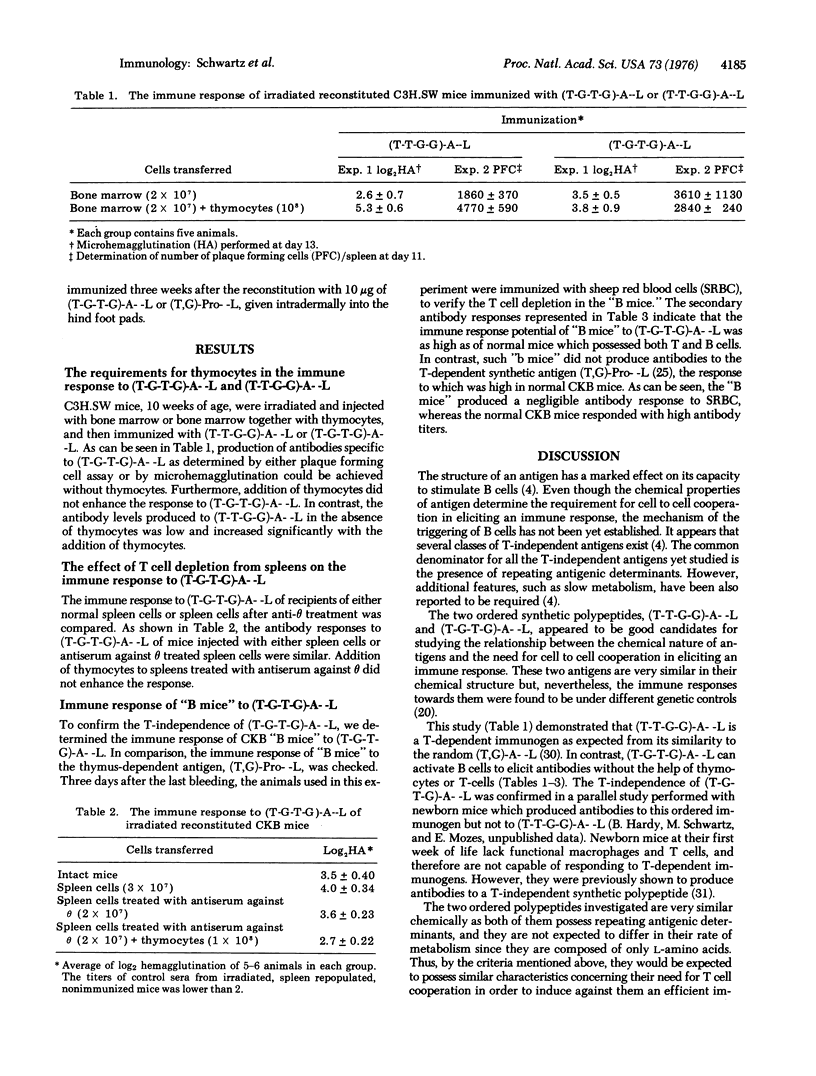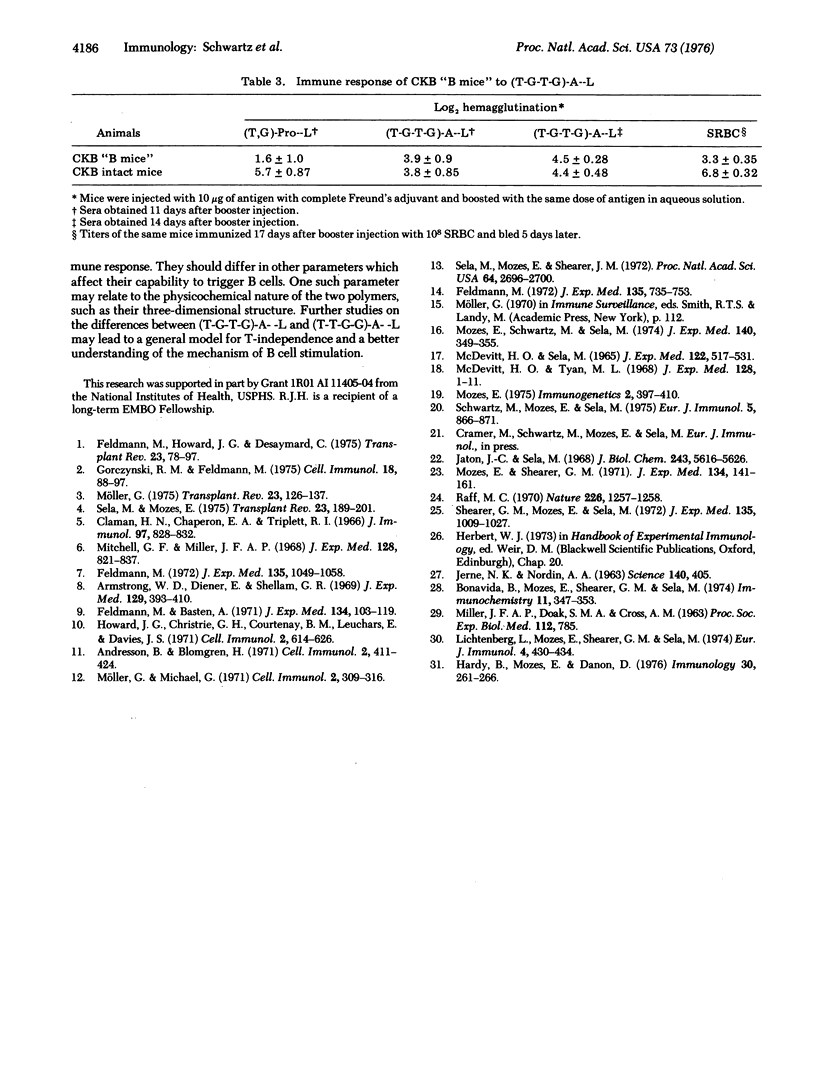Abstract
Two synthetic polypeptides which differ only in the order of amino acids in their NH2-terminal side chains, namely, (Tyr-Tyr-Glu-Glu)-poly(DLAla)- -poly(LLys) and (Tyr-Glu-Try-Glu)-poly(DLAla)- -poly(LLys), were found to be under different genetic control. By three different in vivo systems for thymus-derived cell depletion, it was demonstrated that (Tyr-Tyr-Glu-Glu)-poly(DLAla)- -poly(LLys), which represents the random poly(Tyr,Glu)-poly(DLAla)- -poly(Lys) in the pattern of immune responses and in the quality of antibodies they elicit, is thymus-dependent whereas (Tyr-Glu-Tyr-Glu)-poly(DLAla)-poly(LLys) does not require thymus-derived cell help for efficient antibody production. Therefore, the two ordered polypeptides which are similar chemically differ in parameters, not yet determined, which affect their capability to trigger bone marrow-derived cells.
Full text
PDF


Selected References
These references are in PubMed. This may not be the complete list of references from this article.
- Andersson B., Blomgren H. Evidence for thymus-independent humoral antibody production in mice against polyvinylpyrrolidone and E. coli lipopolysaccharide. Cell Immunol. 1971 Oct;2(5):411–424. doi: 10.1016/0008-8749(71)90052-9. [DOI] [PubMed] [Google Scholar]
- Armstrong W. D., Diener E., Shellam G. R. Antigen-reactive cells in normal, immunized, and tolerant mice. J Exp Med. 1969 Feb 1;129(2):393–410. doi: 10.1084/jem.129.2.393. [DOI] [PMC free article] [PubMed] [Google Scholar]
- Bonavida B., Mozes E., Shearer G. M., Sela M. Immunological unresponsiveness induced in adult mice to synthetic polypeptides built on multichain polyproline and multichain polyalanine. Immunochemistry. 1974 Jul;11(7):347–353. doi: 10.1016/0019-2791(74)90187-6. [DOI] [PubMed] [Google Scholar]
- Claman H. N., Chaperon E. A., Triplett R. F. Immunocompetence of transferred thymus-marrow cell combinations. J Immunol. 1966 Dec;97(6):828–832. [PubMed] [Google Scholar]
- Feldmann M. Cell interactions in the immune response in vitro. II. The requirement for macrophages in lymphoid cell collaboration. J Exp Med. 1972 May 1;135(5):1049–1058. doi: 10.1084/jem.135.5.1049. [DOI] [PMC free article] [PubMed] [Google Scholar]
- Feldmann M., Easten A. The relationship between antigenic structure and the requirement for thymus-derived cells in the immune response. J Exp Med. 1971 Jul 1;134(1):103–119. doi: 10.1084/jem.134.1.103. [DOI] [PMC free article] [PubMed] [Google Scholar]
- Feldmann M., Howard J. G., Desaymard C. Role of antigen structure in the discrimination between tolerance and immunity by b cells. Transplant Rev. 1975;23:78–97. doi: 10.1111/j.1600-065x.1975.tb00150.x. [DOI] [PubMed] [Google Scholar]
- Feldmann M. Induction of immunity and tolerance in vitro by hapten protein conjugates. I. The relationship between the degree of hapten conjugation and the immunogenicity of dinitrophenylated polymerized flagellin. J Exp Med. 1972 Apr 1;135(4):735–753. doi: 10.1084/jem.135.4.735. [DOI] [PMC free article] [PubMed] [Google Scholar]
- Gorczynski R. M., Feldmann M. B Cell heterogeneity - difference in the size of B lymphocytes responding to T dependent and T independent antigens. Cell Immunol. 1975 Jul;18(1):88–97. doi: 10.1016/0008-8749(75)90039-8. [DOI] [PubMed] [Google Scholar]
- Hardy B., Mozes E., Danon D. Comparison of the immune response potential of newborn mice to T-dependent and T-independent synthetic polypeptides. Immunology. 1976 Feb;30(2):261–266. [PMC free article] [PubMed] [Google Scholar]
- Howard J. G., Christie G. H., Courtenay B. M., Leuchars E., Davies A. J. Studies on immunological paralysis. VI. Thymic-independence of tolerance and immunity to type 3 pneumococcal polysaccharide. Cell Immunol. 1971 Dec;2(6):614–626. doi: 10.1016/0008-8749(71)90009-8. [DOI] [PubMed] [Google Scholar]
- Jaton J. C., Sela M. Role of optical configuration in the immunogenicity and specificity of synthetic antigens derived from multichain polyproline. J Biol Chem. 1968 Nov 10;243(21):5616–5626. [PubMed] [Google Scholar]
- Lichtenberg L., Mozes E., Shearer G. M., Sela M. The role of thymus cells in the immune response to poly(Tyr, Glu)-polyD L Ala--polyLys as a function of the genetic constitution of the mouse strain. Eur J Immunol. 1974 Jun;4(6):430–434. doi: 10.1002/eji.1830040609. [DOI] [PubMed] [Google Scholar]
- McDevitt H. O., Sela M. Genetic control of the antibody response. I. Demonstration of determinant-specific differences in response to synthetic polypeptide antigens in two strains of inbred mice. J Exp Med. 1965 Sep 1;122(3):517–531. doi: 10.1084/jem.122.3.517. [DOI] [PMC free article] [PubMed] [Google Scholar]
- McDevitt H. O., Tyan M. L. Genetic control of the antibody response in inbred mice. Transfer of response by spleen cells and linkage to the major histocompatibility (H-2) locus. J Exp Med. 1968 Jul 1;128(1):1–11. [PMC free article] [PubMed] [Google Scholar]
- Mitchell G. F., Miller J. F. Cell to cell interaction in the immune response. II. The source of hemolysin-forming cells in irradiated mice given bone marrow and thymus or thoracic duct lymphocytes. J Exp Med. 1968 Oct 1;128(4):821–837. doi: 10.1084/jem.128.4.821. [DOI] [PMC free article] [PubMed] [Google Scholar]
- Mozes E., Schwartz M., Sela M. Antibody response of inbred mouse strains to ordered tetrapeptides of tyrosine and glutamic acid attached to multichain polyalanine or polyproline. Tyr-Tyr-Glu-Glu is a major determinant of the random poly-(Tyr, Glu)-polyDLAla--polyLys. J Exp Med. 1974 Aug 1;140(2):349–355. doi: 10.1084/jem.140.2.349. [DOI] [PMC free article] [PubMed] [Google Scholar]
- Mozes E., Shearer G. M. Contribution of bone marrow cells and lack of expression of thymocytes in genetic controls of immune responses for two immunopotent regions within poly-(Phe,Glu)-poly-Pro--poly-Lys in inbred mouse strains. J Exp Med. 1971 Jul 1;134(1):141–161. doi: 10.1084/jem.134.1.141. [DOI] [PMC free article] [PubMed] [Google Scholar]
- Möller G., Michael G. Frequency of antigen-sensitive cells to thymus-independent antigens. Cell Immunol. 1971 Aug;2(4):309–316. doi: 10.1016/0008-8749(71)90065-7. [DOI] [PubMed] [Google Scholar]
- Möller G. One non-specific signal triggers b lymphocytes. Transplant Rev. 1975;23:126–137. [PubMed] [Google Scholar]
- Raff M. C. Role of thymus-derived lymphocytes in the secondary humoral immune response in mice. Nature. 1970 Jun 27;226(5252):1257–1258. doi: 10.1038/2261257a0. [DOI] [PubMed] [Google Scholar]
- Sela M., Mozes E., Shearer G. M. Thymus-independence of slowly metabolized immunogens. Proc Natl Acad Sci U S A. 1972 Sep;69(9):2696–2700. doi: 10.1073/pnas.69.9.2696. [DOI] [PMC free article] [PubMed] [Google Scholar]
- Sela M., Mozes E. The role of antigenic structure in B lymphocyte activation. Transplant Rev. 1975;23:189–201. doi: 10.1111/j.1600-065x.1975.tb00158.x. [DOI] [PubMed] [Google Scholar]
- Shearer G. M., Mozes E., Sela M. Contribution of different cell types to the genetic control of immune responses as a function of the chemical nature of the polymeric side chains (poly-L-prolyl and poly-DL-alanyl) of synthetic immunogens. J Exp Med. 1972 May 1;135(5):1009–1027. doi: 10.1084/jem.135.5.1009. [DOI] [PMC free article] [PubMed] [Google Scholar]


